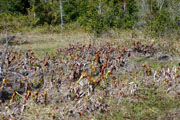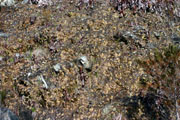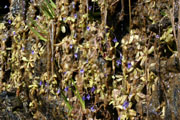On May 3, Jim Miller, Barry Rice, Beth Salvia, and I descended on Harry Tryon's place. Harry's house is on a bluff overlooking the Smith River in Gasquet, California. The view is magnificent. His deck and house are occupied with a wide array of carnivorous plants. For two full days, we visited a number of Darlingtonia californica sites, many of which had Pinguicula macroceras ssp. nortensis, two sites had Drosera rotundifolia, and one site had all three genera.
This wetland area is about 50 m wide and 500 m long, sloping at about 25%, with numerous rivulets. Darlingtonia californica, Pinguicula macroceras ssp. nortensis, and Drosera rotundifolia grow amongst one another in a rather scattered manner.
In 1973, I wrote an article in the Carnivorous Plant Newsletter about this area. Wow! Was that really 35 years ago? In earlier years, there were many cans, bottles, and miscellaneous junk scattered throughout this wetland. Some refer to this area as the Dump Site, although the official Gasquet public disposal site is elsewhere. Over the years, the junk has been removed. The sloping wetland is now bordered by houses; new houses are under construction closeby. Recently, this specific parcel has been designated as an unbuildable wetland, primarily because the constant water flow eliminates the option of septic disposal systems.
Click on the thumbnail for a larger image
Along the bluff on a rocky bench about 20 m above Stony Creek grow dense stands of Darlingtonia. Some of the Darlingtonia are red, but not as red as those found at other sites. This is one of my favorite locations that I return to year after year. Remarkably, it looks the same as it did in 1973, despite being along a popular hiking trail.




The water from the Darlingtonia area percolates over the bluff and keeps the north-facing cliff continually wet. Along the cliff, in bedrock fissures where plants can get a hold, are an occasional Darlingtonia and numerous Pinguicula macroceras ssp. nortensis. Some of the plants are well within the winter high water where they withstand great battering by the turbulent river. Some Pinguicula are still growing under the river water even at this time of year. Several of the Pinguicula have a brownish-red color. There are no Drosera rotundifolia at this site.







The French Hill site is unique in the Smith River area and has some resemblance in appearance to the Butterfly Valley site in the Sierra Nevada. The site is a wet area on an otherwise dry ridge, surrounded by pines and cedars. The standing water is only several cm deep and it is easy to walk through the area without getting wet feet (although Jim somehow managed to become semi-submerged). At this time of year, the area is covered in horizontal dead grass, that, in a few months, will become about 20 cm tall. Darlingtonia are scattered over this 100 m by 100 m area, occasionally forming dense clumps. The plants in the grassy area appear to be struggling. Many have a red color. There are two mounds of sphagnum near the edge of the wet area. Sphagnum is very rare in Smith River sites. Darlingtonia growing in the sphagnum are taller than those in the grass area. One pitcher in the sphagnum was about 1 m tall. Drosera rotundifolia are found throughout this site. There are no Pinguicula.





On serpentine road cuts with perennial seeping water along the South Fork Smith River are extensive stands of Pinguicula and scattered Darlingtonia. These plants cling to the rock faces and occasionally fall with the unstable rock and talus into the roadside ditch where they are scraped away by a road grader during routine road maintenance. At this site, Pinguicula grow along strings of slimy algae on dripping grass leaves. Some Pinguicula grow on mounds of moss. This site receives many hours of harsh direct sun. Many of the Darlingtonia are dark red and the calyx of some flowers were reddish. Barry and Jim braved the traffic to take photos. They are both professional photographers. Barry takes precautions to avoid a social disease, or, perhaps, to reduce wind and diffuse light. Unfortunately, I just hand-hold, point, and click. I also drink the stream water, much to the dismay of my city-fied companions.














An interesting several hundred-meter-long gully is filled with Darlingtonia. The cutbank along the road at the bottom of the gully has Pinguicula. Harry said a couple of years ago, the road cutbank was covered with a thick layer of moss and lots of Pinguicula. Someone completely stripped the moss from the cutbank for a distance of about 100 m, perhaps for the commercial horticultural trade, leaving raw bedrock. The strippers were interested in the moss, not the accompanying Pinguicula. The Pinguicula are slowly returning to the bedrock fissures.

Further up the rough 4-wheel-drive switch-back road, at about 300 m elevation, there is a seep surrounded by Pinus attenuata. The seeping water was intercepted by the road cut. The exposed bedrock reduced competition and subsequently resulted in a dense stand of Darlingtonia on the cutbank and inside road ditch. One could argue that, in this location, the road improved the Darlingtonia habitat. No Pinguicula were found at this location.


The final stop before Barry, Beth, and I left to go home was the famous Covered Bridge site. This site is along a well-traveled road near a number of houses. The hillslope is an active serpentine landslide that feeds rocks and talus into the roadway and inside ditch, along with Pinguicula and an occasional Darlingtonia. Few Darlingtonia grow in the landslide because the substrate moves faster than Darlingtonia can become established. Pinguicula produce numerous gemma during the winter that become widely scattered and establish mature plants more quickly. When the road grader periodically clears the road and ditch, plants are pushed along the road and take root in suitable habitat. Jim generally remained clean and dry (except for an occasional face-first swan-dive into the mud), but Barry just puts his rear-end into the water to get the proper photographic composition.





_________
Bob Ziemer
May 2008